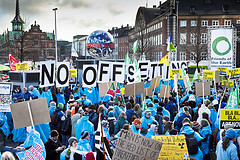
A gap in more than just ideas
By Pascoe Sabido, Friends of the Earth England, Wales and Northern Ireland
June 10, 2011
Sitting at opposite ends of a very long table are Pablo Solon and Jonathan Pershing, lead climate negotiators for Bolivia and the United States respectively. They’re here for the accessibly named ‘Workshop on assumptions and conditions related to the attainment of quantified economy-wide reduction targets by developed country Parties, as requested by decision 1/CP.16, paragraph 38’.” For those who speak English — or who fell asleep while reading — both men are there to give presentations on how we’re going to meet our emissions targets to prevent catastrophic climate change.
We’re facing a big problem — or more specifically, a big gap: what’s being referred to as the “gigatonne gap” means that the emissions reduction commitments on the table are not enough to keep temperatures from rising. Actually, the opposite: according to a study by the United Nations Environment Programme (itself a study of all the studies out there), the current reduction pledges could lead to a 5C rise in global temperatures.
Not only are the pledges made first in Copenhagen and later reaffirmed in Cancun bereft of ambition, they are also full of loopholes. Analysis by the Stockholm Environment Institute shows how far this “creative accounting” is getting us: if emissions from loopholes were included, developed countries would actually increase their emissions! By double-counting offsets, fudging baselines and ignoring aviation and shipping, we’re cooking the books and the planet. We all saw what happened to the financial sector when it used “creative accounting” to hide what was really going on, and it’s the same with the environment. Except when the world’s ecosystems come crashing down, even the biggest government rescue package won’t be able to save us.
The ‘‘gigatonne gap’’ also represents a gap in credibility: by signing the legally binding, science-based Kyoto Protocol in 1997, developed countries in the North agreed to take the lead in cutting emissions — but they’re not. On stage, Pablo Solon’s presentation shows exactly that: developing countries are actually pledging cuts higher than their rich, industrialised counterparts. When offsets are included — through “flexible” market mechanisms — developed countries account for as little as 35 percent of global efforts. Based on a recent SEI report commissioned by Oxfam, slide after slide highlights how such a “pledge and review” system not only violates rich countries’ obligation to take action, but also ignores the principle of “common but differentiated responsibility,” which recognizes differences in resources and ability, as well as the historic responsibility of countries that have already profited from polluting the atmosphere.
With Pablo Solon at one end of the table and Jonathan Pershing about as far down the other end as is practically possible, one could be forgiven for seeing the climate battle summed up right there on stage. But this is not just about two men, nor their two countries, but rather about rich industrialised countries in the North dictating the fate of millions of people in the South. They are doing so not according to what is needed in a time of planetary emergency, nor to what is equitable, but simply by what is deemed politically acceptable. If ever the Earth needed a rescue package, it is now and it wouldn’t come a moment too soon.
Related Posts
Ways to Support Our Work

Read Latest News
Stay informed and inspired. Read our latest press releases to see how we’re making a difference for the planet.

See Our Impact
See the real wins your support made possible. Read about the campaign wins we’ve fought for and won together.

Donate Today
Help power change. It takes support from environmental champions like you to build a more healthy and just world.